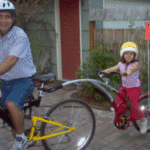I started road cycling about three years ago when I signed up for a two-day 125 mile ride through the Texas Hill Country. Before that, I had not been on a bike in five years and only then to ride leisurely around during vacation. Hardly taxing. To be blunt, I had absolutely no idea what I was in for when I signed up for the ride. I simply thought that I could have fun with friends and raise money for a good cause at the same time.
I have never regretted my reintroduction to cycling, although it had more in common with boot camp than a trip to the spa. If I knew then what I know now, I would have geared up a little more slowly and perhaps started with one or two rides a week with friends, and THEN made the foray into organized rides with less strenuous mile options, say 12 or 20 miles. But since I chose the “dive into the pool and hope to swim technique,” perhaps others who are contemplating road cycling can learn from my mistakes (um, lessons).
Tips for the beginning cyclist:
1) Talk to friends who cycle to get information about road biking. If you do not have any cycling friends, google for cycling clubs in your local area by searching for “cycling,” “clubs|organizations,” and the name of your town, for example, “San Antonio”. Go to meetings or email members who may suggest informal beginner’s rides. These rides may provide beginner tips and information. Also, local shops sometimes rent bikes. That way, you can participate in some informal rides and make sure that cycling is for you before making a big investment.
2) If road cycling is for you, then you’ll need to invest in a bicycle. Again, consult friends, as well as personnel at several bicycle shops. Don’t be afraid to shop around and don’t buy something just because you like how it looks or it “seems to work ok.” Do your homework. Chances are, many bicycle brands will work just fine for shorter routes, but as you advance, you’ll want a bicycle that will advance with you and be comfortable on longer rides. A good bike shop will help you to choose a bicycle according to fit. They should put the bike on a trainer for you, have you get on, and do measurements to make sure that your body fits the frame properly. I can’t tell you how important this is for road biking.
There are also several different levels of gears that come with road bikes. The nicer the gears, generally the more pricey the bike. Of course, other things affect the price as well, such as the material of the frame, i.e. carbon vs. aluminum. In my case, I started out looking at well-known brands, but had a hard time finding a good fit. I’m long-wasted with short legs/arms for my height. I ended up with a Haro Velox VTR that I have been very happy with. Normally, Haro makes BMX bikes, but they ventured into the road bike market a few years ago and wanted to entice buyers. Thus, they included ultegra gears and a light frame for right at $1,000. Comparable bicycles were running $1,500 and up.
3) Clipless pedals (which are really pedals that allow you to clip in, or attach, your shoes to them). I bought clipless pedals and installed them on my bike. I fell over because I could not unclip. I fell over not once, but twice. Both falls happened in the first month that I owned the pedals. My clips were too tight. I had them adjusted and haven’t fallen since. Most people fall at least once. It’s not that bad, but if you are going to try clipless pedals, do not start out with them on busy roads or during rush hour traffic. Falling in traffic wouldn’t be pretty. Having said that, I recommend clipless pedals AFTER you are comfortable with the gears on your bicycle and with riding in general. Don’t try and learn everything all at once like I did. You may also want to get some “training” pedals (you know, like training wheels). They have clips on one side and not on the other, so that you can clip in or not. Your choice. This is a great option when you’re still a little unsure of literally becoming one with your bike.
4) Gears: Love ’em, learn ’em, know how many there are. I’m not the most mechanical person, but I understand the chain rings on my bicycle. It will help on long hilly rides to know which gears switch to which chain rings. You don’t want to be figuring this out at the bottom of a hill.
5) Back to the bike clubs. Attend some meetings either in-person or online and LEARN and OBEY the rules of the road. Use hand signals. Let other cyclists know when you are approaching by saying “On your left”. These and other courtesies specific to cycling can be learned in an hour with the help of an experienced cyclist. They are not only good to do, but they will help you and other cyclists ride more safely.
6) This point will be controversial, but I’ve seen a number of people go down on their noggin. Their helmet saved them. WEAR a helmet.
7) If you ride at night, purchase a headlight and flashers. Wear reflective clothing. I recently almost hit a cyclist who was riding at night along a dark street with no reflective clothing, no flashers, and no helmet. I flat out did not see her. To make matters worse, she ignored a stop sign. (See #5)
8) Ride defensively, as if you are invisible to motorists. Sometimes you are. Don’t assume that you know what any motorist will do. Unless you are an extraordinarily gifted psychic, you’ll find yourself surprised, more than once.
9) Buy the right clothing. Yes, wear the pants with the big padding in the butt. They will make a difference on a 30-mile or 40 mile ride. Trust me. Otherwise, can you say rash and blister? Also, a good biking jersey or similar material will absorb sweat and keep you dry. Wear comfortable sneakers, if you don’t have clip-in shoes and don’t forget to buy a good pair of cycling socks to keep your feet happy. If you’re planning on riding in the rain-but who plans for it, it just happens-have a windbreaker or light jacket with a close fit to cut down on wind resistance.
10) Bicycle accessories. I have a wedge pack that hangs off the seat. I keep my keys, an ID and an extra tube in it. Extra tire tubes come in handy because, at some point, you will have a flat tire. Also, you’ll need at least one water cage for your water bottle, and you may want to consider an odometer that tracks mileage.
11) Drink water. Stay hydrated. Rest when you need to, and, above all, HAVE FUN.



